Egg Yolks Can Take Any Dish To The Next Level. Here's How
There are some foods that have earned their place in the fridge as staple items — foods that are always there in their trusty spot at any given time, and that you find yourself using every which way in the kitchen. One of those foods is eggs. They're quick and easy to whip up, you can eat them for breakfast, lunch, or dinner, and they're one of those rare items that you buy fresh, yet they have a long shelf life.
Eggs are worth all the bang for your buck because of the versatility and nutrition they provide. Think about how many ways you can make an egg; the possibilities are endless. And you're able to do so for a small price since eggs are often one of the most affordable items you can find at the grocery store. One study notes that eggs are highly nutritional, filled with "essential lipids, proteins, vitamins, minerals, and trace elements," and asserts that most of the egg's nutrients are found in its yolk.
And while every part of the egg is useful and beneficial, the nutrient-packed egg yolk, in particular, is a sort of unsung hero of the kitchen — this tiny yellow-orange sphere of vitamins and minerals can go a very long way in dishes that you may never have thought to introduce it to.
How to use egg yolks to elevate your meals at home
There are two main categories we tend to put egg yolks into: breakfast and baking. But they're not just reserved for toast-dipping or making the perfect custard. Egg yolks can do so much when added to savory dishes, sauces, soups, and more. And we're not just talking about a caesar salad dressing or spaghetti carbonara; egg yolks can benefit all kinds of recipes by adding just enough richness to step them up a notch. That's because they act as emulsifiers, bonding other ingredients together and elevating the consistency and flavor of a dish. So let's find out how we can use them from someone who knows egg yolks best: a pastry chef.
Daniel Skurnick, who was the executive pastry chef at Le Coucou and Buddakan in New York, told Food & Wine that he simply adds an egg yolk to any dish that could benefit from richness, thickness, or creaminess. It makes whatever he happens to have lying around at home that much more exciting and enjoyable. And he's full of suggestions — whether it's subtly enriching the flavor of a stew, thickening a pan sauce without flour or a soup without cream, taking a pasta dish to the next level, or even adding more nutrients to a warm breakfast cereal.
Incorporating an egg yolk into your next dish
So you have some ideas now, but how do you actually work an egg yolk into a recipe or a go-to meal at home? Luckily, it's pretty easy to do. In many cases, you'll want to add a yolk to something liquid-based like a soup or a pan sauce. The optimal way to incorporate the yolk is to drop it in (ideally right after you turn the heat off, so the temperature isn't too high) and carefully work it into the liquid to thicken it up a bit. It'll cook, slowly but surely, and as it does you'll find that your dish becomes a little shinier as the yolk begins to gloss over whatever you've got cooking up in there.
For some meals, you can even just plop the raw, separated yolk on top once it's fully cooked and plated (think a bowl of ramen, a pasta dish, or even a salad with a sort of deconstructed dressing). Then the idea is to gently mix the yolk into the dish as you begin to eat, coating everything as you go to enrich the flavor and experience. To add a yolk to a pasta sauce before it's done cooking, Skurnick's method is to make a well in the center of the pasta just before the dish is ready. Add a bit of pasta water, drop the egg yolk in, and continually stir until all of the pasta is delicately covered in that silky goodness (per Food&Wine).
So next time you're mid-dinner prep in the kitchen thinking, "I feel like this could use something..." one little egg yolk may be exactly what your dish needs. Whether it's cured or raw, an egg yolk can completely change your meal.


